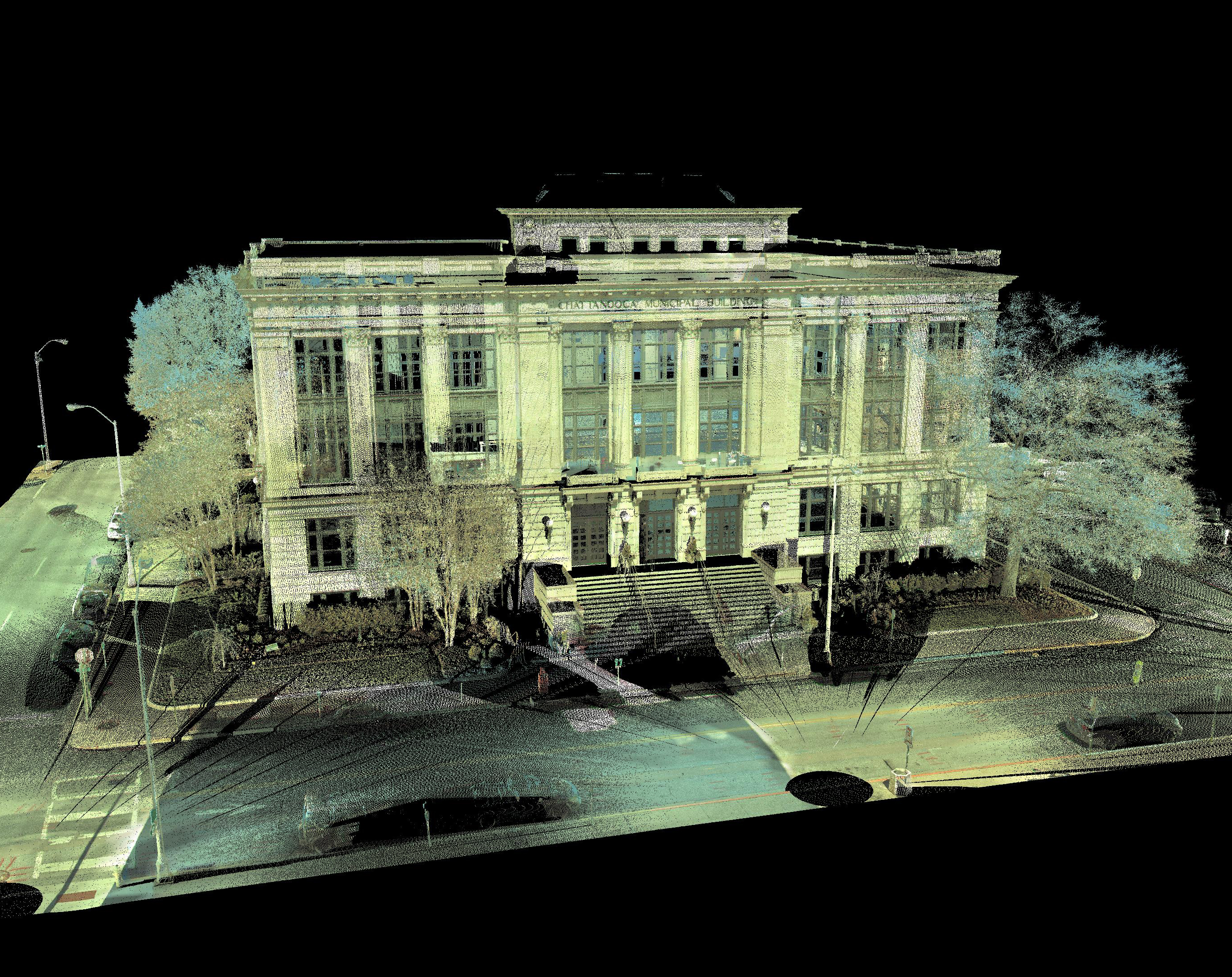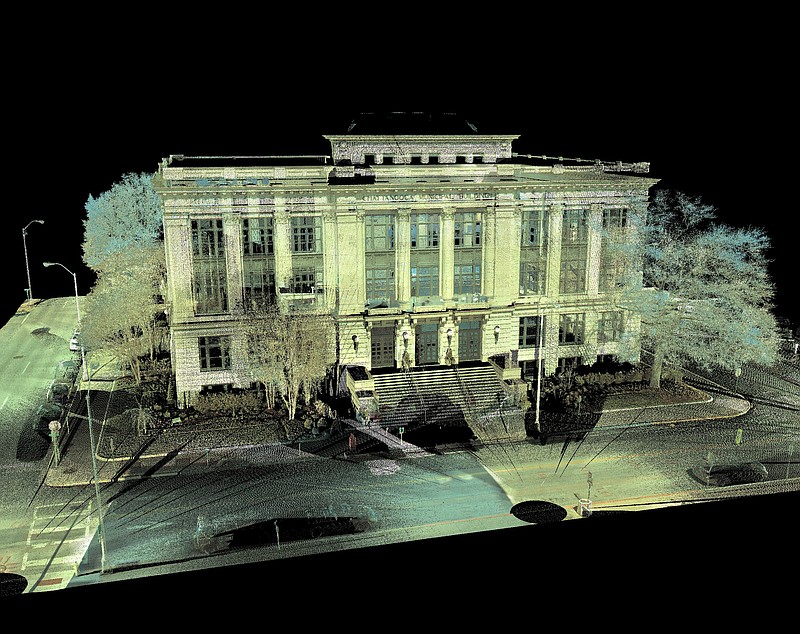 Using new technology, the Chattanooga Police Department's Leica ScanStation C10 combines laser and camera technology. The system can capture details of a crime scene moments after investigators arrive, then reproduce it in three dimensions on a screen. This example shows Chattanooga City Hall from various angles and perspectives.
Using new technology, the Chattanooga Police Department's Leica ScanStation C10 combines laser and camera technology. The system can capture details of a crime scene moments after investigators arrive, then reproduce it in three dimensions on a screen. This example shows Chattanooga City Hall from various angles and perspectives.Sometime next year, Hamilton County jurors will be able to stride past yellow crime scene tape and into a home where a man was shot dead hours earlier.
The jurors may walk into the kitchen - where the slain man still lies on the floor - and peer at the scene from every corner of the room. They can measure the distance between bloodstains, trace the trajectory of the fatal bullets, then walk out into the street to see which way the shooter fled.
And they will never leave the courtroom.
It's all possible because of a briefcase-sized machine with a long name: the Leica Geosystems ScanStation C10. Using laser and camera technology, the ScanStation can freeze a crime scene moments after detectives arrive, then reproduce it on a screen in three dimensions.
"Instead of just seeing a picture of a bullet hole and then looking at a floor plan to see where the bullet hit, you can go in the house, turn a corner, and see the bullet right there in the wall," said Chattanooga Police Assistant Chief Tim Carroll, head of the criminal investigations unit.
The scanner itself doesn't beg a second glance. Its boxy design and bland white color don't spark notions of whiz-bang gadgetry or futuristic crime-fighting. But officials say the machines revolutionize the way detectives gather evidence, how attorneys prepare their cases and how jurors examine data.
HOW IT WORKSOnce the ScanStation is started, its laser travels over every square inch within a roughly 900-foot-diameter area, collecting 50,000 measurement points per second. Afterward, a built-in camera takes panoramic photos of the entire scene. The measurement data - called a "point cloud" - is matched with the pixels from the series of panoramic photos. The result is a color, three-dimensional rendition of the scene from which any linear measurement can be conducted with an accuracy within a quarter of an inch.AT A GLANCE• The 3D scanner was developed about 10 years ago for engineering and surveying purposes.• With its batteries, the scanner weighs about 35 pounds.• The scanner's maximum field of vision is 360 degrees horizontal, and 270 degrees vertical.• The device can store 80 gigabytes of data on its built-in drive.• The scanner is weatherproof and can collect data even in darkness.• Fewer than 100 law enforcement agencies in the country currently have the ScanStation C10. They include the Metropolitan Police in Washington, D.C.; Los Angeles Police Department; Chicago Police Department; and now the Chattanooga Police Department.
"It takes the jury right to the crime scene," said Hamilton County District Attorney Bill Cox, who predicted the scans will debut in Hamilton County courts early next year. "It's what we always attempt to do through photographs, maps and video. This just takes it one step further because it's a more realistic, 3D depiction of the crime scene."
The Chattanooga Police Department is the first law enforcement agency in Tennessee to acquire the Leica system. The Georgia Bureau of Investigation shares four Leica scanners among its 14 agencies and hopes to buy four more.
"It's now the best technology available for documenting and recording crime scenes," said GBI Special Agent Jerry Scott.
GBI agents used the scanners in September to document a double homicide in Rocky Face, Ga., in which a teenage girl and a man were found slain inside a burning house. The agency also used it in March during the high-profile case in Athens, Ga., in which a police officer was shot and killed while responding to a carjacking.
In court, the technology is an answer to what Cox calls a "'CSI' effect" among modern jurors, many of whom are used to a steady diet of crime and courtroom dramas.
"People watch television, and they expect a lot of this high-tech video and audio evidence," Cox said.
Carroll first spotted the ScanStation on a TV show: A&E's "Crime 360," which frequently features imaging pulled from scanners. By November of last year, the department had ordered two ScanStations, assigning one to the crime scene unit and the other to traffic investigations. Each cost the department $210,000 in grant money.
HOW IT WORKS
Chattanooga police have made heavy use of the scanners since putting them to work in April. The city has had 17 homicides since then, and officers have run scans at most of them.
"It has become a standard part of our initial investigation process," said Chattanooga Police Sgt. Darrell Whitfield, who was the first Chattanooga police investigator to train with the equipment.
As detectives work the crime scene, the scanner's tripod stands discreetly to the side, its small green laser flitting over every square inch of all objects within a 900-foot diameter. It collects millions of measurable points within a domelike space, reaching at least 450 feet off the ground.
After seven minutes, the scan is finished, and a camera starts swiveling to snap panoramic photos of every angle of the scene. Each pixel from those images is matched with a point collected by the laser.
In less than half an hour, these scans can be uploaded to a computer, where software stitches together the 3D color diagrams.
The result isn't like a 3D movie, where the images pop out of the screen. But it does allow the viewer - with the click of a mouse - to jump to any vantage point the scanner captured in its line of vision.
Viewers can home in to examine a crack in the sidewalk or expand the view to encompass a city block. And they can measure anything from a cigarette butt to a building's height - to within a quarter of an inch.
"We can get an aerial view when we've never left the ground," Whitfield said. "We can be standing in front of a building, and then be looking out from one of its windows. We can see things we've never been able to see before."
Whitfield gives the hypothetical example of a witness who claims she saw a shooting from the corner of a parking lot. With the program, Whitfield can move to the spot where the witness says she was standing and modify the angle to match her height.
"We now have a sense of what she could have seen from this spot," Whitfield said. "And we can corroborate or disprove her account."
FREEZE THE PAST, PREPARE FOR THE FUTURE
Carroll still has the stencils he used to hand-draw crime scenes back in the 1980s and 1990s. There are tiny outlines for bodies, guns and furniture, which he traced onto graph paper as renderings of a floor plan.
"It got easier when we first started using computers, but we were still working with two dimensions," he said.
And they were working with limited hours and investigators' own physical limitations, said Tony Grissim, who is Leica Geosystems' public safety and forensic account manager.
"Imagine going into a trailer which is a total mess," Grissim said. "You've got a victim on the floor and a gun and a knife and all this other junk around. All those things are part of the crime scene. It may be a few months later that you realize you needed the measurement from the milk bottle to the telephone."
The scanner data gives investigators that second or third or 100th chance to go back to the scene.
"It doesn't replace our investigative work," Whitfield said. "We still take our own pictures, take our own measurements. We still connect the dots. This technology just multiplies the options for how we look at the scene," he said.
Keeping scans of buildings or urban areas on file also allows agencies to prepare for a major security event such as a politician's visit or to plan their response to an event such as a bomb threat.
DIGITIZING THE JUSTICE SYSTEM
The scanner evidence is just one aspect of a major digital overhaul in local courtrooms, Cox said.
In the last five years, Hamilton County courtrooms have become equipped with updated computer systems, live video-streaming technology and projectors allowing attorneys to present new types of digital evidence, including digital video, text message exchanges, Internet history and a car's GPS coordinates.
In September, Cox used an iPad to show a cellphone video of a man's shooting death to a judge.
"I'm acutely aware of the effectiveness of the type of evidence technology now allows us to gather and present to a jury," said Cox. "I think we've been on the cusp or ahead of the curve for a while now."
The 3D scans have started popping up in trials throughout the country. In one trial in Decatur County Superior Court, District Attorney Joe Mulholland of the South Georgia Judicial Circuit used it to pinpoint the location of the shooter.
"I talked to the jury afterward, and they said it was very effective," Mulholland said. ""We have a visual society, and this is one of the ways we are able to accommodate that."
If local attorneys object to using the scanner evidence in court, Cox said, a hearing would determine if it was viable as evidence.
Grissim, who tracks how the ScanStation data is used in trials, said he's seen 100 percent acceptance of the equipment in U.S. courts so far. He added that defense attorneys also have started using the data.
"Even the best investigators have to make subjective choices about what should be photographed and what should be measured. This just shows what's there," Grissim said. "Better information leads to a better chance of someone getting rightfully convicted - or exonerated."

